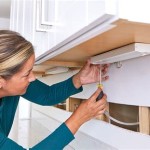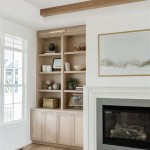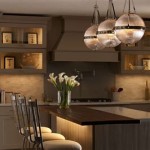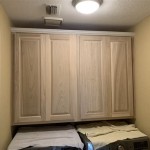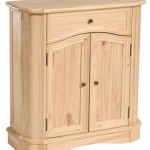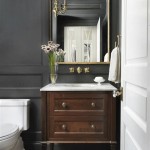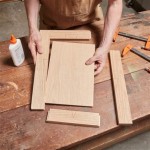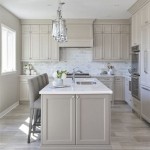Do You Have To Prime Kitchen Cabinets Before Painting Them?
Painting kitchen cabinets is a cost-effective method for revitalizing a kitchen's aesthetic without undertaking a full renovation. However, the durability and appearance of the newly painted cabinets depend heavily on proper preparation, with priming being a crucial step. The decision of whether or not to prime kitchen cabinets before painting requires careful consideration of several factors, including the cabinet material, the existing finish, and the type of paint being used. Understanding these factors is essential for achieving a professional and long-lasting finish.
Priming serves several important functions in the painting process. It creates a uniform surface for the paint to adhere to, blocks stains and tannins that can bleed through the topcoat, and seals porous materials to prevent excessive paint absorption. Skipping the priming step can lead to a number of issues, such as peeling paint, uneven color, and poor adhesion. While there are paints marketed as "paint and primer in one," these products may not always provide the same level of performance as a dedicated primer, especially on challenging surfaces like kitchen cabinets.
The Importance of Priming Based on Cabinet Material
The material of the kitchen cabinets significantly influences the necessity of priming. Different materials have varying levels of porosity and reactivity to paint, making priming more or less critical.
Wood Cabinets: Solid wood cabinets, while generally durable, are porous and can absorb paint unevenly. This can result in a blotchy or inconsistent finish. Knotty wood cabinets are particularly prone to tannin bleed-through, where the natural oils and resins in the wood seep through the paint, causing discoloration. Priming with a stain-blocking primer is highly recommended for wood cabinets, especially those made of pine, cedar, or redwood. The primer seals the wood pores, prevents tannin bleed, and provides a smooth, uniform surface for the paint to adhere to.
MDF (Medium-Density Fiberboard) Cabinets: MDF is a manufactured wood product made from wood fibers and resin. It is commonly used for cabinet doors and frames due to its smooth surface and stability. While MDF is generally less porous than solid wood, it can still benefit from priming. Priming seals the edges of the MDF, preventing moisture absorption and swelling. It also creates a consistent surface for the paint to adhere to, reducing the risk of peeling or chipping. An oil-based or acrylic primer is suitable for MDF cabinets.
Laminate or Thermofoil Cabinets: Laminate and thermofoil cabinets have a smooth, non-porous surface that is difficult for paint to adhere to. These surfaces often have a glossy or slick finish that repels paint. Without proper preparation, paint will likely peel or scratch easily. Priming is absolutely essential for laminate and thermofoil cabinets. A bonding primer, specifically designed for slick surfaces, is required to create a strong adhesive bond between the cabinet surface and the paint. Sanding the surface lightly before priming can further improve adhesion.
Melamine Cabinets: Melamine is a type of laminate that is typically applied to particleboard or MDF. Like other laminates, melamine has a smooth, non-porous surface that is challenging to paint. Priming is necessary to ensure proper paint adhesion. Similar to laminate and thermofoil, a bonding primer is recommended for melamine cabinets after lightly sanding the surface.
Evaluating the Existing Finish and Its Impact on Priming
The existing finish on the kitchen cabinets plays a significant role in determining whether priming is necessary. Factors like the type of paint used previously, the condition of the existing finish, and the presence of any stains or damage all influence the decision to prime.
Cabinets with a Glossy Finish: If the cabinets have a glossy or semi-gloss finish, priming is highly recommended. Glossy surfaces are inherently difficult to paint over because the paint tends to bead up and not adhere properly. Sanding the surface can help to roughen it up and improve adhesion, but priming with a bonding primer is still crucial for ensuring a long-lasting finish. The bonding primer creates a chemical bond with the glossy surface, allowing the paint to adhere effectively.
Cabinets with a Previously Painted Finish: If the cabinets have been painted before, the condition of the existing paint job needs to be assessed. If the existing paint is peeling, chipping, or cracking, it must be thoroughly removed before priming and painting. A sound existing paint finish can be painted over, but priming is still recommended, especially if the new paint color is significantly different from the old color. Priming helps to block the old color and prevent it from bleeding through the new paint. It also provides a uniform surface for the new paint to adhere to, ensuring a consistent finish.
Cabinets with Stains or Damage: If the cabinets have stains from water damage, grease, or food spills, priming is essential. Stains can bleed through the new paint, causing discoloration and ruining the finish. A stain-blocking primer is required to seal the stains and prevent them from seeping through. Similarly, if the cabinets have any damage, such as dents, scratches, or gouges, these should be repaired before priming. Wood filler can be used to fill in the imperfections, and then the surface can be sanded smooth. Priming will help to seal the repaired areas and create a uniform surface for painting.
Cabinets with Dark Paint Colors: When painting cabinets with a light color over a dark color, priming greatly assists in blocking the underlying shade. Without primer, multiple coats of the lighter paint might be needed to achieve full coverage, which can lead to a thick, less desirable finish. Tinting the primer toward the final paint color can further reduce the number of coats required.
Selecting the Right Primer and Understanding Paint Compatibility
Choosing the appropriate primer and considering its compatibility with the chosen paint are vital for a successful cabinet painting project. Different primers possess unique properties suited for specific surfaces and paint types.
Oil-Based Primers: Oil-based primers are known for their excellent adhesion, stain-blocking properties, and ability to seal porous surfaces. They are particularly effective for priming wood cabinets and cabinets with existing stains. Oil-based primers provide a hard, durable finish that is resistant to moisture and mildew. However, they have a strong odor, require mineral spirits for cleanup, and take longer to dry than other types of primers. Oil-based primers are generally compatible with both oil-based and latex paints.
Latex Primers: Latex primers are water-based and have low VOCs (volatile organic compounds), making them a more environmentally friendly option than oil-based primers. They are easy to apply, have a low odor, and can be cleaned up with soap and water. Latex primers are suitable for priming MDF cabinets and cabinets that have already been painted with latex paint. They provide good adhesion and a smooth surface for painting. However, latex primers are not as effective at blocking stains as oil-based primers. Latex primers should be used with latex paints for best results.
Shellac Primers: Shellac primers are known for their excellent stain-blocking properties and their ability to seal knots and tannin bleed. They are a good choice for priming wood cabinets with knotty wood. Shellac primers dry quickly and provide a hard, durable finish. However, they have a strong odor and require denatured alcohol for cleanup. Shellac primers are compatible with both oil-based and latex paints.
Bonding Primers: Bonding primers are specifically designed for priming slick, non-porous surfaces like laminate, thermofoil, and melamine. They contain special additives that allow them to adhere to these difficult surfaces. Bonding primers are available in both oil-based and latex formulations. It is crucial to choose a bonding primer that is compatible with the chosen paint. Always follow the manufacturer's instructions for application and drying time.
Paint and Primer in One: While paint and primer in one products exist, their effectiveness on kitchen cabinets can be questionable, particularly when dealing with challenging surfaces or pre-existing finishes. These products often lack the specialized properties of a dedicated primer, such as stain-blocking capabilities or strong adhesion to glossy surfaces. For optimal results and durability, using a separate primer is generally recommended.
In conclusion, while the decision to prime kitchen cabinets before painting depends on a variety of circumstances, understanding the material, existing finish, and the function of various primer types is vital. Proper preparation, including priming when necessary, will significantly improve the quality, durability, and lifespan of the painted finish, resulting in a kitchen transformation that is both aesthetically pleasing and long-lasting.

Refinish Kitchen Cabinets With Kilz Restoration Primer

How To Prime Cabinets For A Smooth Finish The Turquoise Home

The Best Way To Paint Kitchen Cabinets No Sanding Palette Muse

A Step By Guide To Painting Kitchen Cabinets With Kilz Primer Blog

Diy Painting Your Kitchen Cabinets The Right Way

How To Paint Laminate Cabinets Without Sanding The Palette Muse

Avoid These Mistakes How To Paint Cabinets That Are Already Painted Grace In My Space

How To Paint Laminate Kitchen Cabinets Perfect Finish Tips

How To Prep And Paint Kitchen Cabinets Lowe S

Painted White Cabinets Before And After Reveal Photos Renovated Faith
Related Posts

